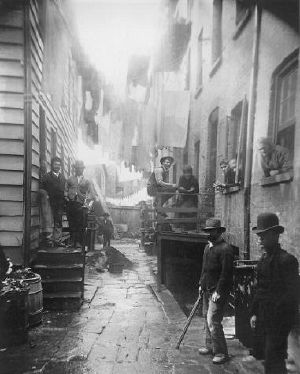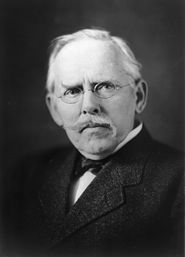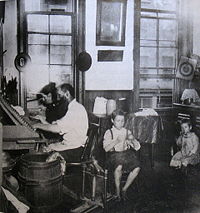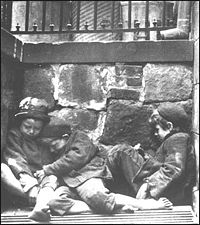Riis, Jacob
(fixed) |
(Started) |
||
| Line 1: | Line 1: | ||
| − | {{Claimed}} | + | {{Claimed}}{{Started}} |
[[Category:Media Professionals]] | [[Category:Media Professionals]] | ||
Revision as of 15:02, 6 October 2007
Jacob August Riis (May 3, 1849 - May 26, 1914), a Danish-American muckraker journalist, photographer, and social reformer, was born in Ribe, Denmark. He is known for his dedication to using his photographic and journalistic talents to help the less fortunate in New York City, which was the subject of most of his prolific writings and photographic essays. As one of the first photographers to use flash, he is considered a pioneer in photography.[1]
Early life
Jacob Riis was the third of fifteen children born to Niels Riis, schoolteacher and editor of the local Ribe newspaper, and Carolina Riis, a homemaker.[2] Riis was influenced both by his stern father, whose school Riis took delight in disrupting, and by the authors he read, among whom Charles Dickens and James Fenimore Cooper were his favorites. At age eleven, Riis's younger brother drowned. Riis would be haunted for the rest of his life by the images of his drowning brother and of his mother staring at his brother's empty chair at the dinner table. [2] At twelve, Riis amazed all who knew him when he donated all the money he received for Christmas to a poor Ribe family, at a time when money was scarce for anyone.[3] When Riis was sixteen, he fell in love with Elisabeth Gortz, Riis moved to Copenhagen in dismay, seeking work as a carpenter.[2]
Immigration to the United States
Riis came to the United States by steamer in 1870, when he was 21, seeking employment as a carpenter. He arrived during an era of social turmoil. Large groups of migrants and immigrants flooded urban areas in the years following the Civil War seeking prosperity in a more industrialized environment. Twenty-four million people moved to urban centers, causing a population increase of over 700%.[1]
The demographics of American urban centers grew significantly more heterogeneous as immigrant groups arrived in waves, creating ethnic enclaves often more populous than even the largest cities in the homelands.[1] Riis found himself just another poor immigrant in New York. His only companion was a stray dog he met shortly after his arrival. The dog brought him inspiration and when a police officer mercilessly beat it to death, Riis was devastated. One of his personal victories, he later confessed, was not using his eventual fame to ruin the career of the offending officer.[2] Riis spent most of his nights in police-run poor houses, whose conditions were so ghastly that Riis dedicated himself to having them shut down.[4]
Journalism career

Riis held various jobs before he accepted a position as a police reporter in 1873 with the New York Evening Sun newspaper. In 1874, he joined the news bureau of the Brooklyn News. In 1877 he served as police reporter, this time for the New York Tribune. During these stints as a police reporter, Riis worked the most crime-ridden and impoverished slums of the city.[2] Through his own experiences in the poor houses, and witnessing the conditions of the poor in the city slums, he decided to make a difference for those who had no voice.[1] He was one of the first Americans to use flash powder, allowing his documentation of New York City slums to penetrate the dark of night, and helping him capture the hardships faced by the poor and criminal along his police beats, especially on the notorious Mulberry Street. In 1889, Scribner's Magazine published Riis's photographic essay on city life, which Riis later expanded to create his magnum opus How the Other Half Lives.[4] This work was directly responsible for convincing then-Commissioner of Police Theodore Roosevelt to close the police-run poor houses in which Riis suffered during his first months as an American. After reading it, Roosevelt was so deeply moved by Riis's sense of justice that he met Riis and befriended him for life, calling him "the best American I ever knew."[4] Roosevelt himself coined the term "muckraking journalism," of which Riis is a recognized example, in 1906.[2]
Marriages and later life
At age 25, Riis wrote to Elisabeth Gortz to propose a second time. This time Gortz accepted, and joined Riis in New York City, saying "We will strive together for all that is noble and good".[5] Indeed, Gortz did support Riis in his work, and he spent the next 25 years using his artistic medium to advance the concerns of the poor. During this time, Riis wrote another twelve works, including his autobiography The Making of an American in 1901.[4] In 1905, his wife grew ill and died. In 1907, Riis remarried, and with his new wife Mary Phillips, moved to a farm in Barre, Massachusetts. Riis's children came from this marriage, but Riis died on May 26, 1914, at his Massachusetts farm. His second wife would live until 1967, continuing work on the farm, working on Wall Street and teaching classes at Columbia University.[6]
Criticism
Contemporary critics have noted that, despite Riis's sense of populist justice, he had a deprecating attitude towards women and people of certain ethnic and racial groups.[1] In his autobiography, The Making of an American, Riis decided to allow his wife to add a chapter examining her own life. After letting her begin an honest and evocative biographical sketch over several pages titled "Elisabeth Tells Her Story," Riis decided his wife had had enough of the stage: "I cut the rest of it off, because I am the editor and want to begin again here myself, and what is the use of being an editor unless you can cut 'copy?' Also, it is not good for woman to allow her to say too much."[7]
Furthermore, Riis's writings revealed his prejudices against certain ethnic groups, cataloguing stereotypes of those with whom he had less in common ethnically. Riis’ middle class and Protestant backgrounds weighed heavily in his presentation of How the Other Half Lives. Both instilled a strong capitalist idealism; while he pitied certain poor examined as worthy, many others he viewed with contempt. According to Riis, certain races were doomed to failure, as certain lifestyles caused families’ hardships.[1] An example of Riis's ubiquitous ethnic stereotyping is seen in his analysis of how various immigrant groups master the English language: "Unlike the German, who begins learning English the day he lands as a matter of duty, or the Polish Jew, who takes it up as soon as he is able as an investment, the Italian learns slowly, if at all."[8]
Works
- How The Other Half Lives (1890)
- The Children of the Poor (1892; new edition, 1902)
- Out of Mulberry street (1896), a collection of fiction
- A Ten Years' War (1900)
- The Making of an American (1901; new edition, 1913), his autobiography
- The Battle with the Slum (1902)
- Children of the Tenements (1902)
- The Peril and the Preservation of the Home (1903)
- Theodore Roosevelt, the Citizen (1904)
- The Old Town (his birthplace) (1909)
- Hero Tales of the Far North (1910)
- Neighbors: Life Stories of the Other Half (1914)
Memorials
- Jacob Riis Park, located on Rockaway Peninsula in the Gateway National Recreation Area, Queens, is named after Riis.
- Jacob Riis Triangle, located in Richmond Hill, Queens, is named after Riis.
- PS 126M The Jacob August Riis School, a New York City public school in Manhattan's Lower East Side serving kindergarten through grade 8, is named after Riis.
- Jacob Riis Settlement House, a multi-service community based organization, is located in the Queensbridge Houses, in Long Island City, Queens, NY. www.riissettlement.org
Notes
- ↑ 1.0 1.1 1.2 1.3 1.4 1.5 James Davidson and Mark Lytle, “The Mirror with a Memory,” After the Fact: The Art of Historical Detection (New York: McGraw Hill, 2000).
- ↑ 2.0 2.1 2.2 2.3 2.4 2.5 Len Bernstein, Photographica World: The Journal of the Photographic Collectors Club of Great Britain (no. 98, April, 2001; available online here).
- ↑ Eli Siegel, "Aesthetic Realism: A Tripartite Study," The Right of Aesthetic Realism to Be Known, no. 247, (Dec 1977).
- ↑ 4.0 4.1 4.2 4.3 Teaching History Online: "Jacob Riis".
- ↑ Eli Siegel, "Art as Ethics," The Right of Aesthetic Realism to Be Known, no. 738 (May 1987).
- ↑ Francesca Pitaro, "Guide to the Jacob Riis Papers" (Manuscripts and Archives Division, New York Public Library, 1985; available online as PDF file here).
- ↑ Jacob A. Riis, The Making of an American (London: Macmillan, 1970), 283.
- ↑ Jacob Riis, "The Italian in New York," chap. 5 of How the Other Half Lives (New York: Charles Scribner's Sons, 1890; available online here).
ReferencesISBN links support NWE through referral fees
External links
- Jacob Riis page from the Open Collections Program at Harvard University. Immigration to the United States, 1789-1930 collection. Includes links to fully digitized copies of 10 of his books.
- How the Other Half Lives (complete online edition)
- Works by Jacob Riis. Project Gutenberg
Credits
New World Encyclopedia writers and editors rewrote and completed the Wikipedia article in accordance with New World Encyclopedia standards. This article abides by terms of the Creative Commons CC-by-sa 3.0 License (CC-by-sa), which may be used and disseminated with proper attribution. Credit is due under the terms of this license that can reference both the New World Encyclopedia contributors and the selfless volunteer contributors of the Wikimedia Foundation. To cite this article click here for a list of acceptable citing formats.The history of earlier contributions by wikipedians is accessible to researchers here:
The history of this article since it was imported to New World Encyclopedia:
Note: Some restrictions may apply to use of individual images which are separately licensed.


